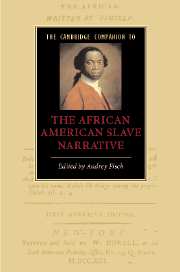Book contents
- Frontmatter
- Introduction
- Part I: The Slave Narrative and Transnational Abolitionism
- Part II: The Slave Narrative and Anglo-American Literary Traditions
- Part III: The Slave Narrative and the African American Literary Tradition
- Part IV: The Slave Narrative and the Politics of Knowledge
- 11 Harriet Jacobs: a case history of authentication
- 12 Frederick Douglass’s self-fashioning and the making of a Representative American man
- 13 Beyond Douglass and Jacobs
- 14 Black womanhood in North American women’s slave narratives
- Further Reading
- Index
14 - Black womanhood in North American women’s slave narratives
from Part IV: - The Slave Narrative and the Politics of Knowledge
Published online by Cambridge University Press: 28 July 2007
- Frontmatter
- Introduction
- Part I: The Slave Narrative and Transnational Abolitionism
- Part II: The Slave Narrative and Anglo-American Literary Traditions
- Part III: The Slave Narrative and the African American Literary Tradition
- Part IV: The Slave Narrative and the Politics of Knowledge
- 11 Harriet Jacobs: a case history of authentication
- 12 Frederick Douglass’s self-fashioning and the making of a Representative American man
- 13 Beyond Douglass and Jacobs
- 14 Black womanhood in North American women’s slave narratives
- Further Reading
- Index
Summary
Slavery is terrible for men; but it is far more terrible for women. Superadded to the burden common to all, they have wrongs, and sufferings, and mortifications peculiarly their own.
(Harriet Jacobs, Incidents in the Life of a Slave Girl)Formerly enslaved women, like formerly enslaved men, were active participants in eighteenth- and nineteenth-century abolition movements. They participated as fugitives helping other fugitives; as speakers; as organizers and fundraisers; and as the writers of slave narratives. Slave women seeking to represent their experience for their audiences shared some of the problems slave men encountered when telling their stories. In an era in which citizenship was limited to white men, representations of the often humiliating experiences of slave men and women potentially exacerbated former slaves' vulnerability in their readers' eyes. If male slave narrators who sought readers' sympathy for themselves and abolition had to contend with feminizations of slave men as “sambo,” as well as depictions of oversexed and violent men, formerly enslaved women had to contend with similar disparaging stereotypes. De-gendered in the eyes of middle-class readers because they performed field and manual labor (where they were often in the majority), yet also viewed as oversexed because of their sexual vulnerability, slave women faced especially contradictory circumstances when they entered the spheres of antislavery publicity. Whether as a “mammy,” a “Jezebel,” or as a masculinized non-woman, when slave women offered first-hand accounts of slavery they were exposed to an intense scrutiny that conflicted with cultural norms that insisted on the privacy of “woman.” Slave women consciously shaped their narratives in direct response to these problematic contexts, as writers and as narrators.
- Type
- Chapter
- Information
- The Cambridge Companion to the African American Slave Narrative , pp. 232 - 245Publisher: Cambridge University PressPrint publication year: 2007
- 2
- Cited by



